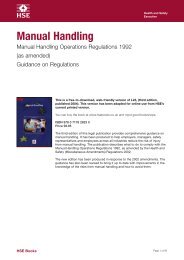Making Companies Safe - what works? (CCA ... - Unite the Union
Making Companies Safe - what works? (CCA ... - Unite the Union
Making Companies Safe - what works? (CCA ... - Unite the Union
You also want an ePaper? Increase the reach of your titles
YUMPU automatically turns print PDFs into web optimized ePapers that Google loves.
provides stronger evidence that seminars may be effective in stimulating action. But <strong>the</strong>re are<br />
a number of reasons why future action should not be based on <strong>the</strong> results on this single study.<br />
First, seminars are only likely to attract more highly motivated companies. So seminars do not<br />
provide an effective medium for reaching <strong>the</strong> poor performers or small employers. Second,<br />
<strong>the</strong>re are problems in judging <strong>the</strong> relative effectiveness of seminars as compared to<br />
inspections, since <strong>the</strong> seminar sample was self-selecting whilst <strong>the</strong> inspection sample was not.<br />
Also, <strong>the</strong> smaller number of inspections undertaken means that <strong>the</strong>re was not sufficient data<br />
to compare <strong>the</strong> effects of inspections with seminars in relation to most of <strong>the</strong> different<br />
sectors. So whilst seminars appeared particularly effective at stimulating action in construction<br />
and agriculture, we do not know how this compares to <strong>the</strong> effects of inspections within <strong>the</strong>se<br />
sectors. Also, since construction and agriculture have particularly high rates of death and<br />
injury relative to o<strong>the</strong>r sectors, it would be unwise, on <strong>the</strong> basis of such limited data, to<br />
substitute seminars or similar activities for inspections within <strong>the</strong>se sectors.<br />
Finally, even if employers were driven primarily by a conviction that it is morally right to<br />
protect <strong>the</strong> health and safety of workers, <strong>the</strong> assumption that information-based strategies<br />
will be enough to secure OHS improvements amongst <strong>the</strong> majority of organisations is based<br />
on a ra<strong>the</strong>r simplistic notion of firm behaviour. The evidence shows that occupational health<br />
and safety will generally be one amongst many o<strong>the</strong>r priorities competing for management<br />
attention and resources. And <strong>the</strong> consequences of this are apparent in <strong>the</strong> findings of many<br />
UK studies, which show that compliance is often patchy even when levels of knowledge<br />
and understanding are high. This indicates that knowledge is not enough – absent <strong>the</strong> threat<br />
and reality of enforcement – to secure adequate improvements in <strong>the</strong> health and safety<br />
performance of individual firms.<br />
This does not mean that campaigns and educational activities are not important. But it does<br />
imply that <strong>the</strong>se activities are at best a ‘partial strategy’ 45 that will only be effective if <strong>the</strong>y<br />
occur in <strong>the</strong> context of consistent and frequent inspections backed by enforcement activity.<br />
Moreover, <strong>the</strong> study by Rakel et al. shows that information and guidance may be insufficient<br />
drivers even in <strong>the</strong> context of firms that appear highly motivated since <strong>the</strong> study showed that<br />
levels of action following both seminars and mailshots were lowest amongst those firms<br />
expressing a wish for more information. 46 Consequently, while it may be important to explore<br />
more effective methods for communicating with organisations, and especially SMEs, it is also<br />
crucial that this occurs within a framework where <strong>the</strong>re is a credible level of enforcement.<br />
1 Wright et al. (2004: 36).<br />
2 Hillage et al. (2001: 24).<br />
3 For instance Honey et al.’s (1997) evaluation of <strong>the</strong> ‘Brea<strong>the</strong> Freely’ campaign, Thomson-MTS (1993a: 7)<br />
and Hillage et al. (2001: 24).<br />
4 Hillage et al. (2001: 23).<br />
5 Wright et al. (2000).<br />
6 Wright et al. (2000: 22, 98).<br />
7 See Wright et al. (2000: 113-115).<br />
8 Wright et al. (2000: 40).<br />
9 The data tell us nothing about ei<strong>the</strong>r <strong>the</strong> adequacy of any action taken, nor whe<strong>the</strong>r <strong>the</strong> most significant health risks within<br />
each organisation have been addressed, nor whe<strong>the</strong>r firms were in compliance with specific health and safety regulations.<br />
10 Hillage et al. (2001: 24).<br />
11 Wright et al. (2000).<br />
12 Honey et al. (1997).<br />
13 Hillage et al. (2001: 34).<br />
14 Rakel et al. (1999).<br />
15 Wright et al. (2000); and Mayhew et al. (1997). 65
















